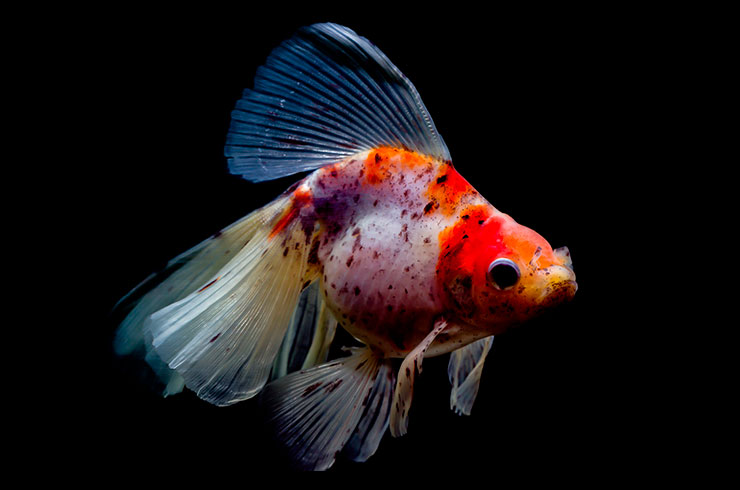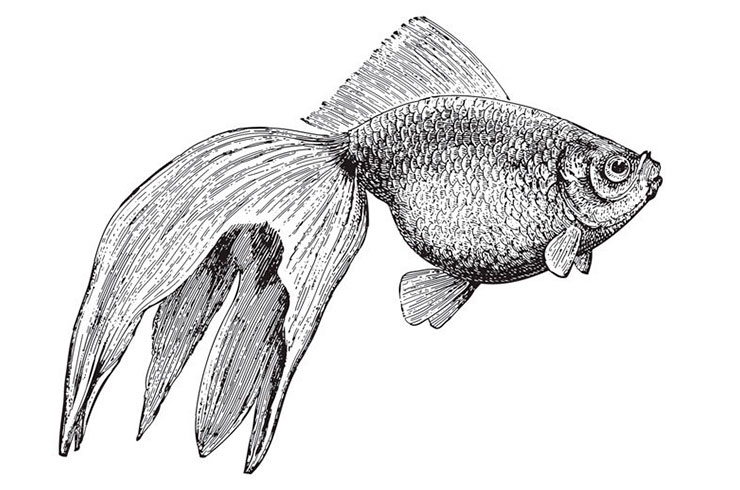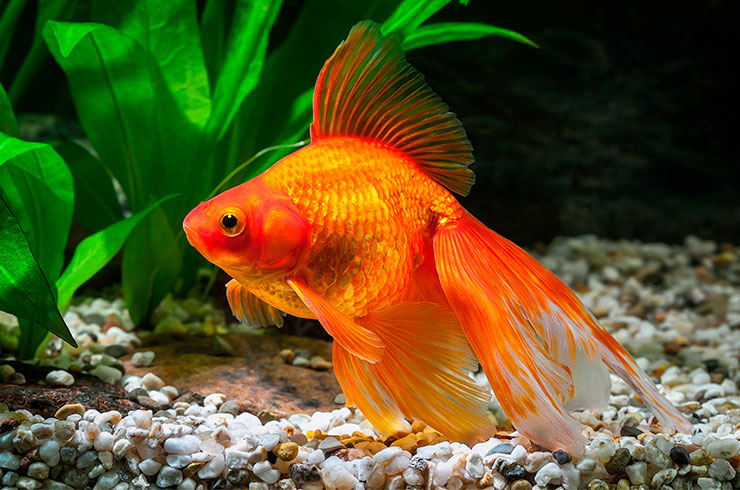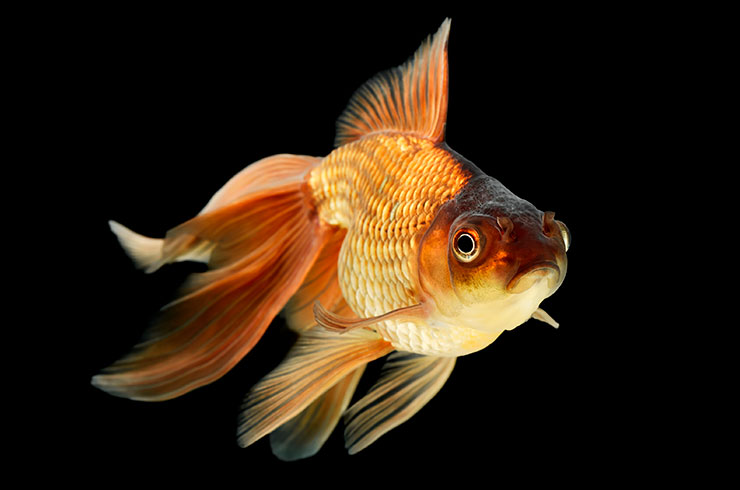Goldfish are popular aquarium inhabitants that can be found around the globe. Thanks to many years of selection, a large number of breeds have been created, differing in the color of the scales and the shape of the body. And although the veiltail is a capricious pet, the number of those who want to have this golden beauty is not decreasing.
General information
Veil tail is one of the most beautiful breed forms of goldfish, which has specific characteristics for keeping. The main aesthetic value of this fish is its long, thin fins, similar to a veil. Unfortunately, the long tail is not only the pride of the veil-tails but also their burden: it is prone to injury and often becomes a breeding ground for infection. Often there are also problems with the swim bladder due to the fact that the selection went towards the shortened body, and this led to the modification and compaction of the internal organs.
Appearance
The body shape of the veil-tail is ovoid or spherical, the head smoothly passes into the back. The fins are thin, long, almost transparent. The anal fin is double, the caudal fin is very long, often 6 times the length of the body. Particularly valuable specimens have a tail consisting not of two fused fins, but of three or even four. The color is very diverse, the most popular are individuals of bright red or white (light cream) color. In a suitable aquarium, the fish grows up to 20 cm.
History of appearance
The initial breed for breeding was the riukin – a variety of goldfish with a shortened body, a convex abdomen and a characteristic hump from head to dorsal fin. The selection process focused on individuals with the longest fins.
Currently, there are two types of veil-tails: classic (Veiltail) – with a lush and hanging tail fin and ribbon (Fringetail) – with a tail in the form of a ribbon or fork. Each of them has its own standards that are used when evaluating individuals at local and international exhibitions.
Care and maintenance
Despite the fact that in general goldfish are quite hardy, veil tails have some specific characteristics when kept. Considering that the maximum fish size can be 20 cm, it is necessary to choose an aquarium of a suitable size. Best of all, if one fish has at least 50-80 liters of water. In such conditions, the veil-tail feels most comfortable. Large rounded pebbles are usually used as soil, since the fish are very fond of digging up the soil. The size must be chosen so that an adult fish cannot swallow the stone. It is advisable that the aquarium does not have decorations with strongly protruding and sharp edges, about which the veil tail can damage its chic fins.
Veil-tails, especially large, rather voracious fish, therefore release a lot of waste into the water. This, together with love to constantly stir up the soil and raise the dregs, leads to a rapid accumulation of metabolic products in the water. It is recommended to use powerful canister external filters for water purification and modern compressors to enrich the water with the required amount of oxygen. Do not forget about regular water changes: weekly you need to change 25-30% of the water to fresh, this will not allow harmful compounds to accumulate in the aquarium.
Water hardness should be in the range of 6-18 ° dGH, acidity around 7.0.
Like other goldfish, veil-tails are happy to pluck the delicate leaves of aquatic plants. Therefore, when keeping in an aquarium, it is best to use hard-leaved or fast-growing species (for example, Anubias, Elodea, Vallisneria gigantea, some Cryptocorynes). They must be planted so that the fish do not have access to the roots, otherwise sooner or later they will be dug up by the veil tails.
Compatibility
The best solution for keeping veil-tails will be a species aquarium. This will help to avoid damaging the fins by other fish species, in addition, tropical fish will be uncomfortable living with cold water lovers. You should not plant a goldfish with small fish, even in spite of its sluggishness, sooner or later a trifle can become a victim of a veil tail. The best neighbors will be other short-bodied breeding forms of gold with a similar temperament – telescopes, ranches, pearls.
Feeding the Veiltail
Veil-tails are omnivorous fish, therefore, both animal and plant components must be present in their diet.
The best option for feeding your veil tails is a high quality dry food for breeding goldfish species. Their advantage is that they are completely balanced, contain the entire range of nutrients and vitamins, and are well absorbed by fish. The latter is especially important, since undigested substances will get into the water with fish waste and can cause the accumulation of toxic nitrogenous compounds.
Tetra’s GoldFish range is specifically designed to meet the nutritional needs of goldfish. Thanks to the wide variety of delivery forms, you can easily choose the food that your pets like best.
Considering the huge popularity of veil tails in the world, Tetra produces a whole line of specialized food for goldfish – Tetra Goldfish. All feeds contain the Clean & Clear Water formula: the ingredients of the feed are well absorbed, which reduces the amount of fish excrement and allows the aquarium water to remain clean and transparent for longer.
Tetra Goldfish Gold Japan is a premium pellet feed for all breeding goldfish (veil tails, oranda, telescopes, riukins, etc.). Mini pellets quickly soften in water and gradually sink to the bottom, which is consistent with the habit of Japanese goldfish to seek food at the bottom. Natural carotenoids enhance the color of fish. Rich in plant proteins for optimal digestion.
If veil tails prefer floating food in the form of chips, then Tetra Goldfish Pro is a good choice – an innovative food made using gentle low-temperature technology that allows you to retain more nutrients and vitamins. The red rim of the chips contains nutrients, the yellow center contains krill to enhance the natural coloration and support muscle development.
Veil-tails with a red or golden body will benefit from Tetra Goldfish Color, a highly nutritious food with natural color enhancers that allows goldfish to shine in all their glory. Available in the form of flakes and granules.
It is necessary to feed the goldfish several times a day in small portions, which will be eaten by the fish in a few minutes.
Reproduction and breeding
Veil-tails become pubertal by the first year of life. Gender dimorphism is practically not pronounced, it is possible to pick up a pair only during the mating season. To maintain the purity of the breed, attention must be paid to the selection of producers.
For spawning, an aquarium of 40 liters or more with good aeration and lighting is suitable. The water level should be about 20 cm. Producers often eat their eggs, therefore it is recommended to install a net with a large mesh at a height of 1-2 cm from the bottom. Spawning is stimulated by an increase in temperature and a large water change.

